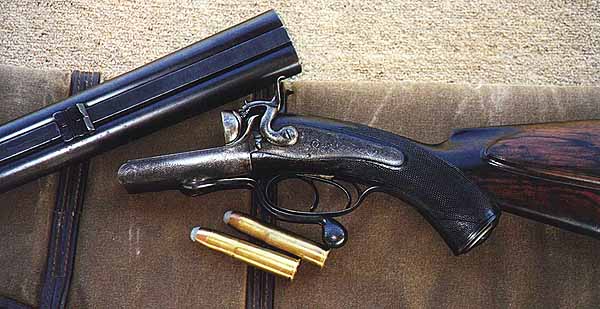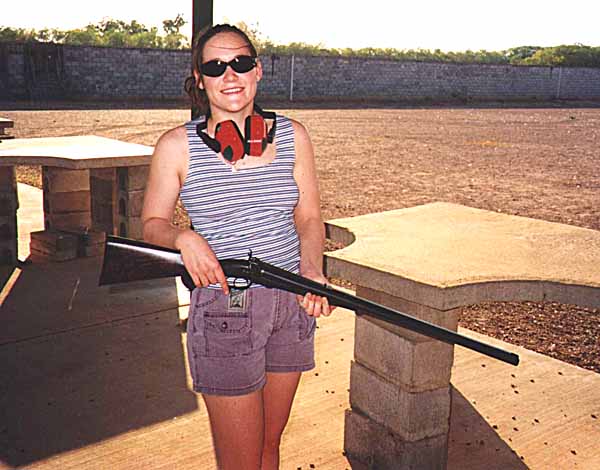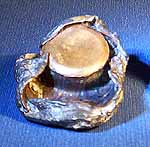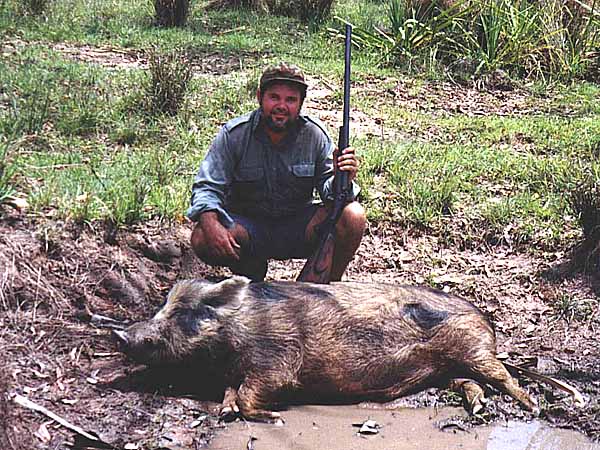ONE OF THE HARDER ONES
ALEXANDER HENRY'S 20-BORE/.577 EXPRESS
by
'Marrakai'
I was about to step back out into the glare of Melbourne’s Whitehorse Road, when something in a dim corner of the Century Arms gun-rack caught my eye. Straining for a better look, I experienced that tiny flutter of excitement as the unmistakable shape of a classic old black powder double express came into focus. A closer examination revealed that the rifle was in a somewhat sorry state, with patches of dry rot in the fore-end and wrist, and a cracked toe on the pistol grip. The locks were held to the gun with brown packaging tape due to the absence of the retaining screw, and the right hand mainspring, nipple, and firing pin were missing. Perfect! Not only might I be able to afford it, but it would also nurture my insatiable desire to resurrect old classics and get them bellowing once again.
The rifle turned out to be a striking example of Alexander Henry’s best workmanship from the latter part of the nineteenth century, with a Jones’ Patent under-lever and back-action rebounding locks. Although the bores showed light peppery pitting throughout, the original Henry rifling was in very good shape. The wonderfully figured stock featured Henry’s characteristic shadow-line cheek-piece, with trap grip-cap and laminated horn butt plate. The fore-end was lever-locked although only one screw was securing the iron to the stock-wood at the time of purchase. Externally, the metalwork carried that marvelous silver-brown appearance which is often referred to as “patina” but is really a varnish of smoothly worn rust.

A classic example of the British double express by Alex Henry.
…and the engraving! Even the folding sight leaves feature full coverage of fine scroll. The grip-cap, hammers and top tang are works of art. The action body and lock-plates show only about 70% cover, but the work is very fine, and faultless. Typical Alexander Henry. The chambering is typical Alex Henry as well, one of his proprietary cartridges made by necking down the 20 bore 2 3/4 inch brass rifle case to .585 inch. The original ‘factory’ load carried a 560 or 570 grain patched lead projectile ahead of 6 drams (167 grains) of black powder, exactly duplicating the more common .577 3-inch Express.
Subsequent correspondence with Frank Findlow, a keen vintage gun historian and devotee of the rare 20/.577 in the US, established that the rifle was made as a “Best Quality” double barrel express, finished on the 6th of November 1882. It weighed 11 1/4 pounds when it left Edinburgh and was regulated for a load of 6 3/4 drams, slightly heavier than the standard load, using what the books called a “solid bottle case”. It was sold to a Mr. W. (or N.?) Furnival Esq. It had a standing sight plus 2 leaf sights, the standing sight being set for 80 yards. One leaf was marked for 150 yards, the other for 220 yards, although the ledger originally specified 200 yards for the second leaf and had been corrected. The change may have been necessary on account of the heavier-than-normal charge for which the rifle was apparently regulated, listed as 6 ¾ drams or 185 grains! The front bead was size No. 6. It is always interesting to compare these old vintage guns with their original specifications, and I was delighted to discover that the Alex Henry had not been deliberately altered in any way during the intervening century.
So, to work. The first requirement was to get the locks attached to the rifle! Fortunately, my store of spare parts offered up a long cheese-head screw with the correct thread to serve as the lock retaining pin, so after a little lathe-work to alter the length and head dimensions, I could at least dispense with the packaging tape.
A further search of the spare parts bin turned up a nipple from an old pommie shotgun which had the correct thread, but an oversized hex-head. More work for my poor lathe, followed by some careful filing, and the job was done. The replacement firing pin was no trouble of course, so now all that prevented proper functioning of the locks was a mainspring. What fun that proved to be!
I'm rather embarrassed to admit this, but my first attempt at making a spring, by copying the existing one, resulted in a roughed-out mirror image but with the locating pin on the wrong side! Oh well, start again then! For anyone who has never attempted to make and fit a mainspring from scratch, I can thoroughly recommend the experience as good occupational therapy (...although therapy of a different kind may be required afterwards!). Even though the work will rarely be seen, I spent a lot of time shaping and polishing to achieve a worthy match. Eventually the new spring was fitted, and although the rebound sear engagement is slightly shorter than planned, the action of both locks feels identical and the replacement spring has never failed to function flawlessly.
The next hurdle of course was to be ammunition. Simple, I thought. If Alex Henry could neck down 20-bore brass cases 120 years ago, why not do the same? A few phone calls quickly revealed that brass 20 bore cases in Australia were fairly scarce. The fine berdan-primed CBC cases turned up occasionally, however they were only 2 1/2 inches long, so no joy there. I knew that the .600 Nitro case was roughly equivalent to a 3 inch 20 bore, so a chat with Bruce Bertram resulted in the delivery of a couple of sample .600s together with a handful of .600/.577 cases, better known as the .577 Rewa. The micrometer revealed that a shortened Rewa case could work with shoulder pushed back and some lathe work on the rim.
My phone calls had also revealed that Clive H_ once owned one of these rare firearms, and a set of Peter Davern's full-length sizing dies had accompanied its sale to Barry E_ who was still the proud owner at the time. I simply can't thank those guys enough. Unfortunately Barry’s press couldn’t accommodate the oversize dies, so after boosting the phone company’s profits still further, the agreed plan was to take delivery of the Bertram Rewa cases in Darwin, shorten the overall length to 2 3/4 inches, reduce the rim thickness from 65 to 54 thou (to exactly fit my gun’s headspace) and the rim diameter from .80 to .75 inch. I then sent the cases to Clive, who completed the full-length sizing with Barry’s dies in Melbourne, and subsequently posted the cases back to me, and the dies back to Barry!
OK, so that took care of my first twenty shots. What then? I decided to make up a neck-sizing die by a quick and easy method I had used a few times before: cheap Lee RGB dies in .45/70 were softened and bored out with a slight taper and abrupt shoulder to perfectly neck size the fired 20/.577 cases. Only the neck enters the die. My long-suffering excuse for a lathe had trouble handling the boring job, however with generous assistance from Ray W_ and his monster machine, the task was soon accomplished. The seating die received similar treatment, but with a permanent epoxy resin seater-stem molded in over a loaded cartridge (using cling-wrap as the release agent!). Now to business....
Ah, not quite. Another potential hurdle awaited me in bullet selection. My intention was always to make up a light nitro load with jacketed bullets. In this way I could keep the pressure down, get the best accuracy out of the lightly pitted barrels, and hunt all day in the humid tropics without having to wipe the bore. The excellent Woodleigh 650 grain bullet was the obvious choice, with its thin jacket and soft core which works so well in large-bore Henry rifling, however I had my doubts about its ability to stabilize in the very slow twist rate of Henry's barrels.
A quick call to Shirley and Geoff McDonald of Woodleigh Bullets resulted in the generous offer of a quantity of ‘shop-soiled’ .577 projectiles to test in the rifle prior to parting with any hard currency. Turns out there was no cause for alarm: after working up cautiously from a low 75 grains of AR2208 (Varget), I eventually settled on 93 grains behind the 650 grain bullet, with a half-inch saddle-felt wad to take up the space. Primers are the excellent Remington 9 1/2 M bought locally in Darwin.

Daughter Nikki enjoys shooting the old classic.
This load cuts beautiful snake-eyes just above the 10-X at 25 yards, and groups about 2 inches apart at 50 yards. Composite groups average around 3 1/2 inches wide by 2 inches high at the latter distance, shot standing with a post support (I don't like sitting down to shoot this firearm!). Velocity is around 1650 fps at the muzzle, and you can’t get the smile off my face. Graeme Wright's second edition of ‘Shooting the British Double Rifle’, with its pressure data for the .577 x 3 inch 'nitro for black' load, has encouraged me to add another grain or two of powder to finally bring the barrel groups tightly together. Since the rifle was regulated for a higher-than-normal black-powder load anyway, I should be confident in approaching 1700 fps with pressure still safely below 8 tons.
By this stage more than 18 months had passed, and I was itching to see how the old girl would perform in the field. Henry didn't build his lovely express rifles for punching paper: they were, and still are, the quintessential hunter's arm. Unfortunately the ‘wet’ got started a bit early that year, with some rain falling nearly every day from October 1st, but I was determined to check out a couple of old haunts ‘down the track’.
Carrying an 11 pound double all day in the heat and humidity of Australia’s Top End 'build-up' season might not be everyone's cup of tea, but I can think of few better ways to spend a weekend. Wandering alone for miles on foot through remote bush, with only a heavy double for company, effectively removes the last 100 years worth of 'progress' with all its trappings. The hunter finds himself on a level playing field with the likes of Baker, Selous, Neumann, et al (if only for a day or two at a time!). Marvelous stuff!
The first day afield with the Alex Henry saw a rather shaky start however, with no less than three blown chances on buffalo due to the swirling and unpredictable 'build-up' breezes. I also missed a chance at a good boar jumped from his bed under a pandanus, by hurriedly cocking the left hammer and trying to pull the front trigger! I now cock both hammers, regardless!
Eventually I completed a successful stalk on a mob of feral horses grazing up a low ridgeline, and flattened the lead mare from about 40 paces. It was just like dropping a piano on the unfortunate equine. At the shot, a cloud of dust appeared with four hooves pointing skyward! The projectile had struck the feeding animal on the front of the right shoulder and penetrated over 4 feet to the left hip. It expanded to 1.2 inches across and still weighed 531 grains! Who could ask for better performance?

One of the small mobs of buffalo seen earlier had included a respectable bull, which inspired a couple of successive trips back to the same area. The next weekend yielded a very good boar over 250 pounds in the gully below the brumby carcass, stalked in his wallow and shot from about 15 yards. The bullet passed through both shoulders into the mud and was not recovered. He never knew what hit him. I was really beginning to like this rifle!

The first boar to fall to the Alex Henry.
After passing up lesser game for the remainder of the day, I was trudging exhausted back along a creek-line towards the car, when a pair of reasonable buffs emerged from a secluded wallow. They stood looking down their noses at me from about 75 yards, so I shot the bull nicely under the chin. He staggered off for about 50 yards, and as I stalked in thinking a finisher might be needed, over he went. He fell so heavily that one horn stuck deeply into the soft earth and was very difficult to extract!

Buffalo killed with a single 650 grain Woodleigh from 75 yards.
A week later I combed the area again looking for the big bull, but by this time the whole place was getting pretty wet from early-season storms and although I was on fresh sign all day, I never saw so much as a hair. A careful stalk past the remains of last week's buffalo in the late afternoon yielded another top quality boar, jumped from his wallow but standing for the shot at about 20 paces. Hit high on the shoulder, he was flattened instantly but the projectile didn't exit. After removing the jaw I began searching for the bullet amid the wreckage of gristle and bone, but was having a bit of trouble finding it in such a tough animal.

This big tusker dropped to a high shoulder shot.
At that point an immense tropical thunder-storm broke directly overhead, complete with spectacular lightning strikes on the adjacent iron-stone ridge. As the car was still miles away I abandoned my dissection and set off. Striding back through the lashing rain I was soon drenched to the skin, but derived much inner comfort from the fine old Alex Henry in one hand, and an exceptional set of trophy tusks in the other. I knew this would be my last hunt for the year, and was lucky not to get the vehicle bogged on the track out.
So, what’s next? A re-stock is probably on the cards eventually, but for now I decided to carefully patch the existing wood, which is far too beautiful to simply discard. Rainy days were spent making screws to replace the motley selection in the fore-end, while I waited impatiently for the next dry season. Meanwhile, the occasional big game rifle shoot at the Micket Creek Range in Darwin helped to satisfy the urge to burn a bit of nitro. One of these days we'll get a viable Big Game Rifle Club up and running in the Territory!
Was it all worth it? Most serious rifle enthusiasts would acknowledge the enormous satisfaction to be derived from restoring an old stager like this Alex Henry, and returning it to the game fields well over a century later. I have other doubles which are easier to carry and shoot, and comparatively simple to load for, but the extra effort required to resurrect this lovely old rifle has certainly resulted in increased pride of ownership and a greater personal reward.
This article first appeared in THE BIG GAME EXPRESS, journal of the Big Game Rifle Club of Australia No.73, July 2000